Descriptions of Small- and Large-Scale Projects
Small-Scale Project: Organization Website Development
The small project involved creating a website for a research organization, and it captured all information about its core departments. The departments included human resources, research, development, quality control, supplies, and procurement. The website had email functionalities that facilitated internal and external communication of organization affairs; it was developed using Java programming language. The website was developed at the cost of $1500, and it was completed by a team of three professionals for a total of 14 days.
Large-Scale Project: Construction of Footbridge
The large project involved constructing a footbridge on a highway and was expected to cost $1,000,000 within a period of four months. It was facilitated by a large team comprising project managers, structural engineers, quality control professionals, and geologists.
Knowledge Areas of Small- and Large-Scale Projects
The ten knowledge areas according to the Project Management Body of Knowledge include:
Project Integration Management: Integration management reflects activities that hold the project as a single entity. It entails creating a tool called the project charter, which initiates the whole exercise. The charter is used to improve the venture’s success, and it has categories including inputs, tools and techniques, and the outputs as displayed in Table 1 below.
Inputs: Documentation, project plan, agreements, organization process assets
Tools and techniques: Expert judgment, data gathering, team skills, meetings, and minutes
Outputs: Charter and the assumptions log
Table 1: Project Charter
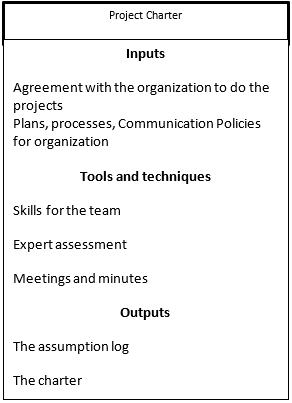
Project Scope Management
This area outlines the project’s work because scopes continuously change. Therefore, it is important to clearly define boundaries and expectations at the beginning of every project cycle. The scope management plan is a document within the project plan management. The scope statement defines the project’s boundary and needs to reduce risks that might arise. It also has the work breakdown structure (WBS), a tool created to monitor the project deliverables to their logical conclusion. Both the small and the large projects have a Work Breakdown Structure. The website project has activities within each phase of the development cycle.
Project Schedule Management
This knowledge area entails aligning tasks to schedules; each task is given timelines from the time they commence to its completion. The costs attached to every task are mentioned alongside the timeline. The project management plan tool has the schedules, the responsibilities of the employees, and the situations which may prompt changes. Other than the schedule plan, the activities are defined, tasks are orderly sequenced, and activities have estimated duration, as shown in Table 2 below. Earned value evaluation technique is used to determine a project’s status, whether behind or ahead and the extent as percentages.
Table 2: Project Schedule Management Plan-Small Project
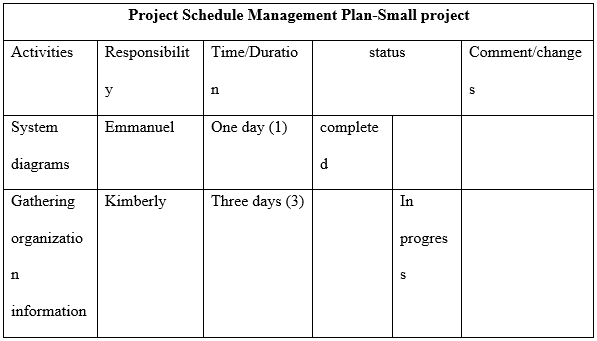
Project Cost Management
Project costs are about the budget, which needs to be established by estimating and monitoring goals to be satisfied with the end product. Cost Management Plan utilizes methodologies involving the establishment of a project budget, procedures for control, and the criteria for the necessary changes. Costs are estimated, and the frequent application of Earned value analysis is utilized to determine the project status. The small project entails buying materials, as opposed to the large one with activities such as purchases, wages, and salaries administration. The budget will reflect all the money being utilized while monitoring is done to ensure the goals are achieved.
Project Quality Management
Quality management in projects is a function of time and cost; the quality management plan indicates the end product and services’ quality requirements. The deliverables are evaluated to determine conformity to the quality specifications. A quality management plan can exist as an isolated tool or be part of the project management plan.
Project Resource Management
Having a great project team positively impacts a project’s success. The need to acquire a motivated team will guarantee satisfaction by tracking individual and team performance. Human Resource Management Plan is a document that outlines the responsibilities and positions concerning the project structure. The tool ensures there are enough resources, cost estimations, resource control, and the aspects of capacity building.
Project Communication Management
Projects have teams and stakeholders that require constant information to be relayed, developing a communication plan to keep all relevant stakeholders informed about progress and changes. A communication management plan reflects the communication procedures and the stakeholders (Muszyńska, 2016). The reflection entails management and monitoring of the communication relating to project status as well as doing reviews of the plan.
Project Risk Management
Risk management in projects helps in the identification of threats hence ensuring the success of the project. A Risk Management Plan is a tool that helps in the identification of risks, categories, and priorities. There is a risk register, a tool that is used to list all the potential risks. Techniques such as qualitative and quantitative analysis are done to determine the probability of occurrence and impacts. The risks are constantly monitored in the risk register; the ones who have expired and are no longer a threat are eliminated from the document, as shown in Table 3.
Table 3: Risk Register for the Small Project
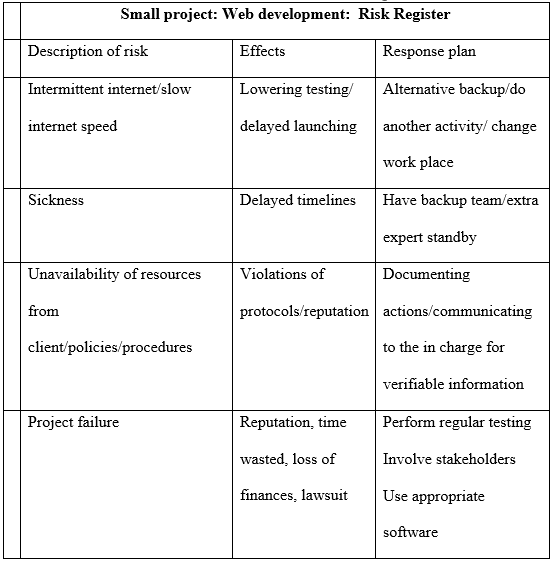
Project Procurement Management
This knowledge area plans for conduct and controls of procurement. It has the project procurement plan, a tool that identifies the project’s external procurement requirements and the specifications for the contractors. Contractors are hired, and the process involves providing a statement of the project, proposals, terms of reference, getting responses, and settling on vendors who will get the work done. Both the small and the large projects require signing contracts; the procurement plan helps in the identification of different personnel for the large project.
Stakeholder Management
Stakeholders are well addressed in the project management plan and are among the most important in the project cycle. The project begins by identifying the project stakeholders at the initiation phase, and their opinions are gathered and considered. They must be at all times engaged and monitored to check if their needs have been addressed. The small and the big project have interested parties; the small project has the workers and the departmental heads whose views have to be included. The large project has the government stakeholders, the project sponsor, and the public members who are the footbridge’s intended users.
Similarities and Differences in Tasks for the Two Projects (Why and How)
The two projects have distinct tasks given below for proper conclusion, one being for website development and the larger one for footbridge construction.
Similarities
Both projects have stakeholder management activities that require need to be well-articulated and satisfied in the long run. The foot-bride will be used by the public who understand the area well and the funding authority with specifications to be addressed. The two projects have budgeting to be done to meet the available funds. Thus, it is necessary for the Cost Management Plan. The footbridge project has materials and many laborers to be procured, hence, the need for a Procurement Management Plan. Both projects have risks to be assessed and placed on the risk register and eventually eliminated upon the expiry when the risks are not posing any threats to the projects.
Differences
Both projects have risks, although their magnitudes vary based on size. The variation exposes larger projects to more risks which have to be well documented and managed until the completion stage. The activities for the projects vary since one project involves coding while the other is a project involving manual work, physical materials, high costs, and a high number of the labor force. Figures 1,2 and 3 below illustrate risk assessment for the two projects.
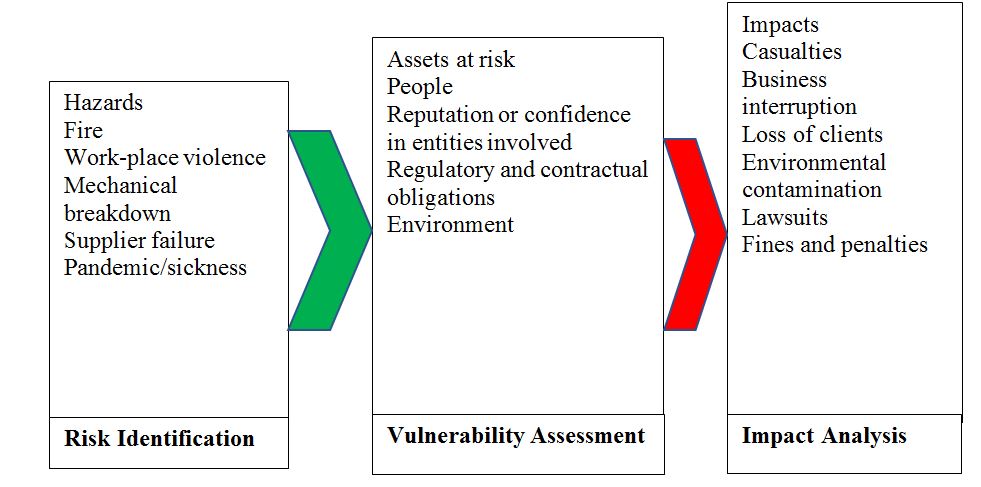
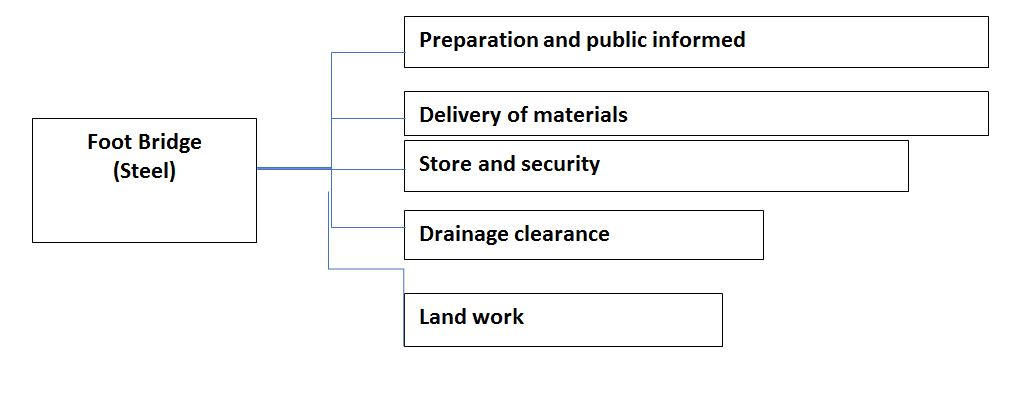
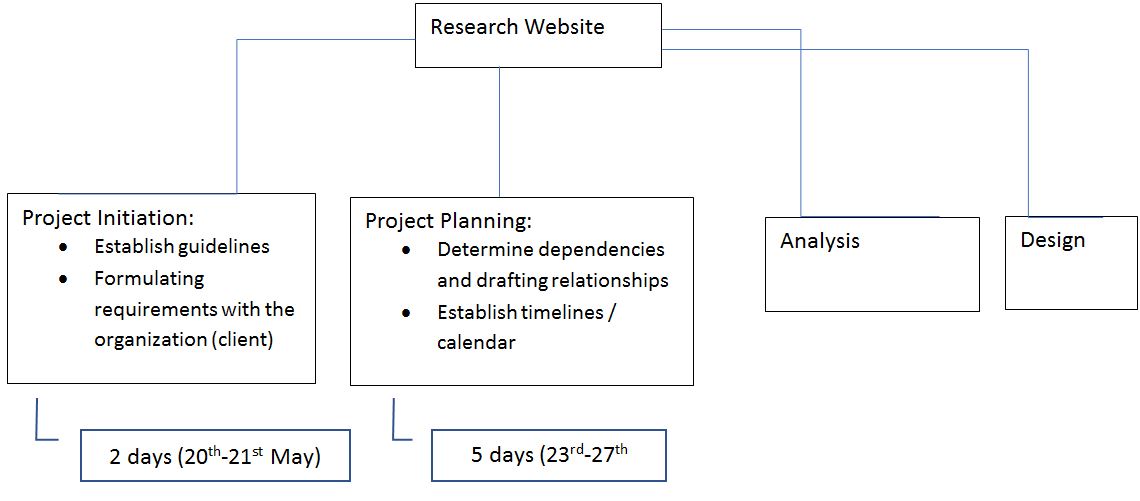
Assumptions for the Large Project
- The current number of workers is constant for the entire project period.
- The legal assistant will be available to help in the development of the contract.
- The project will not exceed its stipulated timeline
- The project budget will sustain the activities to the completion phase.
Assumptions for the Small Project
- The resources for developing the website will be accessible and available from the initial stage of the project.
- The website will not allow ads other than the organization’s information and promotions.
- The website will function in any environment without security loopholes.
Reference
Muszyńska, K. (2016). Project communication management patterns. Proceedings of the 2016 Federated Conference on Computer Science and Information Systems, 8(1), 1179–1188. Web.